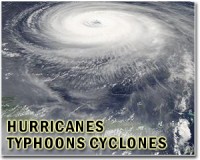| . |  |
. |
Greenbelt MD (SPX) Nov 30, 2010 The year 2010 was accurately predicted by the National Oceanic and Atmospheric Administration (NOAA) to be an active one with 14-23 tropical cyclones and 8-14 hurricanes predicted. NOAA's National Hurricane Center (NHC) in Miami, Fla. subsequently named 19 storms with 12 reaching hurricane strength. The 2010 Atlantic hurricane season was the most active since the record breaking season of 2005. Hal Pierce of the Tropical Rainfall Measuring Mission, or TRMM satellite team at NASA's Goddard Space Flight Center in Greenbelt, Md. created a comparison between the tropical cyclone rainfall occurring in 2005 and 2010. These tropical cyclone rainfall analyses were both made at NASA Goddard using TRMM-based, near-real time Multi-satellite Precipitation data (TMPA).TRMM is a joint mission between NASA and the Japanese space agency JAXA. "It is immediately obvious from this comparison that the major difference is the locations of tropical cyclones," Pierce said. "During the 2010 hurricane season more hurricanes formed in the eastern Atlantic near the Cape Verde islands. These storms were steered around the south and western edge of the Atlantic subtropical high and recurved without touching the United States mainland. For this reason the highest tropical cyclone rainfall totals (between 28 and 32 inches or 71.1 to 81.2 centimeters) were located over the open waters of the Atlantic north of Puerto Rico. Southern Texas was the only location in the United States where 2010 tropical cyclone rainfall was greater than in 2005." A major concern early in the 2010 season was that hurricanes passing through the Gulf of Mexico would worsen the Deepwater Horizon oil spill disaster that occurred on April 20, 2010. It was feared that a hurricane moving through the oil spill would push oil deep into beaches and estuaries along the northeastern Gulf of Mexico but in 2010 most tropical cyclones were steered away from the mainland. Hurricane Alex ended up only causing a five day delay in the oil spill clean-up efforts. In 2005, TRMM satellite estimates showed the highest tropical cyclone rainfall totals (between 28 and 32 inches or 71.1 to 81.2 centimeters) were located over the Caribbean Sea, eastern Gulf of Mexico, western Cuba and over the waters in the Atlantic off the southeastern U.S. The largest rainfall totals appear in pink. For more information about individual storms in the 2010 hurricane season, visit NASA's 2010 Hurricane page storm index at http://www.nasa.gov/mission_pages/hurricanes/archives/index.html. For information about the 2005 storms, which include Katrina, Rita and Wilma, visit the Hurricane page storm index of 2005 here.
Share This Article With Planet Earth
Related Links National Oceanic and Atmospheric Administration (NOAA) Bringing Order To A World Of Disasters When the Earth Quakes A world of storm and tempest
 US spared hit during record hurricane season
US spared hit during record hurricane seasonMiami (AFP) Nov 24, 2010 The 2010 Atlantic storm season was twice as active as normal but what really amazed forecasters was that a record 12 hurricanes formed but never made landfall in the United States. The hurricanes and 19 named tropical storms over the Americas and the Caribbean during the June 1-November 30 season did contribute to some of the worst flooding in decades in Central and Southern America. Qua ... read more |
|
| The content herein, unless otherwise known to be public domain, are Copyright 1995-2010 - SpaceDaily. AFP and UPI Wire Stories are copyright Agence France-Presse and United Press International. ESA Portal Reports are copyright European Space Agency. All NASA sourced material is public domain. Additional copyrights may apply in whole or part to other bona fide parties. Advertising does not imply endorsement,agreement or approval of any opinions, statements or information provided by SpaceDaily on any Web page published or hosted by SpaceDaily. Privacy Statement |